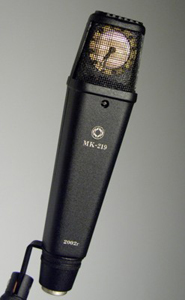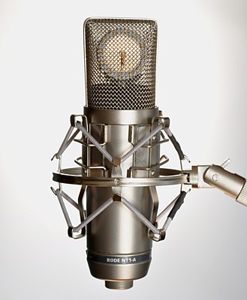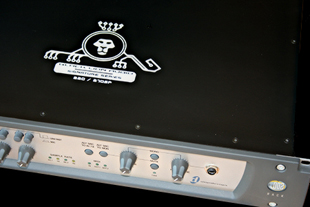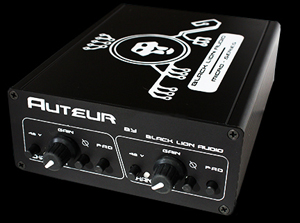Re-Tooling In The New Year: Gear Mods & DIY Electronics
As we get further into the new year, savvy studio owners clear out closets, take stock of what tools have been collecting dust, and decide what to repair, what to jettison, and what to sell to help soften their tax burden. Today we explore a fourth option: Gear Mods.
Designing sustainable hit products for a broad market requires that manufacturers look for places where they can shave costs: A savings of five cents on resistors here, a few dollars in loosened quality control there, and developers can strike a useful balance between cost, performance, and sustainable profits. By their nature, economies of scale require compromises- compromises that the re-designers we visited refuse to make.
The first stop on our tour of the re-tools brought us to OktavaMod‘s Michael Joly. Joly is a personable and responsive tech who has made a name for himself by designing upgrades for the most popular offerings from Rode, Blue, Apex, and of course Oktava.
It’s been years since Joly began toying with one of the first affordable large-diaphragm condenser microphones available in the U.S., the Oktava MK-219. Although this Russian-made mic featured sturdy build quality and respectable sound, Joly wondered what corners he could paste back on the microphone to help it better stand up to the venerable U87, whose role it hoped to fill at a fraction of the price.
“I spent a lot of time studying the mic, just holding it, looking it over and asking questions,” says Joly. One of the first things he did was cut off the front grill slats and convert the thick protective mesh to a single resilient layer. “That change alone makes the open area larger and reduces the internal coloration of the head-basket. Right away you have a mic that’s much more clear and accurate. The transient response instantly improves.”
Although a dozen or more of these small changes go into this or any of his mods, Joly is a results-focused engineer who’d rather serve the entree than lecture about the recipe: “I’ve found my clients want to know about the results” he says, “not the resistors.”
To that end, Joly strives toward a personal sonic benchmark that he developed through years of work at dbx and Earthworks. “I want to take some of the question marks out of upgrading a microphone. I’m not into offering a Chinese-menu full of different options, or asking my clients to jump through hoops to figure out what they want. I develop a sound that resonates with me and then offer it up.”
The positive response to these mods encouraged Joly to keep pursuing his singular sonic vision. He explains that he’s after a tone with body, one that owes its heritage to the classic Neumann designs:
“I appreciate what the [AKG] C12 does, but that’s not my sound. I think of The Beatles recording around a U48, and to me, that’s the sound of pop music.” The OktavaMod sound, he says, is “slightly mid-forward, with a useable proximity effect, and a flat, sibilance free-top end.”
This flavor suits Joly’s customers, who “have turned away from overly bright microphones” and ship their affordable workhorses to Cape Cod, MA to be tamed of resonant peaks and errant top-end.
Joly continues to rethink popular microphone designs each year in hopes of giving them an edge: “I launched the Rode NT1 mod last January, and it’s the fastest selling mod I’ve ever done. It’s popularity is already approaching the Oktava 012 and 219 mods in magnitude, and they’ve been on the market for over 5 years!”
When asked about the popularity of this new mod, he comments: “There’s a lot of nt1s out there. It’s an affordable mic with a good reputation, but the more people use it the more they say: ‘I like the mic, but I’m having trouble with sibilance. Can you do something about that?’”
Joly’s mods start as low as $99.00 for a critically-acclaimed upgrade to the Oktava MK-012. Joly’s newly-proven Rode NT-1 modification, which adds a custom-designed capsule and head-basket while retaining Rode’s super-quiet electronics, runs $379.00.
Black Lion Audio: Suped-Up Interfaces & More
Our next call took us to the workshop of Matt Newport, who spearheads the Chicago-based team Black Lion Audio. Although they’re quickly growing a reputation for their original designs, Black Lion is still best-known for their popular mods of the Digidesign 002 and 003. Like OktavaMod, Newport’s company grew on a reputation for customer service, surprising sound quality, and accolades on internet forums.
The Black Lion story begins with an Alesis 3630 and a dare: “I loved recording music and was working on a project with a friend. We didn’t have a big budget or a lot of gear,” says Newport. Noticing a talent for circuits, Newport’s friend challenged him to try a mod of his Alesis 3630: “There’s no way you can make this thing sound better.”
With affection, Newport states that the 3630 was “designed to give you the most noise and hiss and pumping possible.” So he swapped out the VCA as well as the input and output transformers, and began performing these in-depth mods himself, and selling DIY kits. “When [the mod] came out, I was met with skepticism, which was frustrating at first. But then the word got out: ‘Hey, this thing actually sounds good’”.
The first 002 mod was born out of a customer request: “I started with the MOTU interfaces, because that’s what we were using for a recording project. Once I offered those, people just started asking for a mod on the 002. I figured I’d give it a shot, and the next thing we knew, we could barely keep up!”
Since then, these hard-working Chicagoans have grown to a team of twelve that knocks out proven upgrades on Digi 002s, 003s, and 192s on a tight schedule. These suped-up boxes see action on sessions with artists as varied as Alison Kraus, MGMT, Beyonce, and Slayer.
In addition to improving the analog front-end, Black Lion technicians alter the rate of the internal clocks to “provide fat midrange with deep, extended bottom-end”.
Successes here have inspired the Black Lion team to fill a niche by designing their own high-quality, low-cost preamps and clocks from scratch.
Matt Newport breathes diodes, dreams circuits, and will happily talk design theory for long stretches. However, the black Lion ethos itself is simple: “We try to work hard to offer the best quality sound for the least dollars.”
This simple approach has its own challenges: “because of our human perceptions, companies tend to do better when they price products higher than they need to. It’s a weird aspect of human psychology: When offered something that performs the same for less money, a few people will say “great I’ll take it!”. The rest think ‘Nah, I want to spend more and get the prestige piece.’ That’s why the thing that has moved our products best has always been word-of-mouth.
“Thankfully, people tell their friends, and swear up and down that the products sound amazing, even though they don’t cost as much as some of the biggest names.”
A new mod to a 002R or 003R essentially doubles the cost of the interface. Regardless, Black Lion’s customers believe in the upgrades enough that they’re willing to wait on line for the privilege.
Samar Audio & Microphone Design and The Wider World of Mods
For classically-trained concert pianist and audio designer Dr. Mark Fouxman, each new microphone is an adventure and an individual work of art. His journey in audio began decades ago in Soviet Siberia where, faced with a shortage of recording equipment, he learned to build his own.

Fouxman’s ($149) mod of the AKG C1000 re-seats the capsule closer to the grill and adds a less reflective wire mesh, to complement his electronic upgrades.
Fouxman learns from the classics and strives to make microphones perform as a cohesive whole: “The best microphones are very well-organized systems. The capsule design influences the electronics, which ask for its own choice of output transformer,” he says in a deep Russian accent. “But many mics today are designed very cut-and-paste. It’s like taking a pair of eyes from Jennifer, a nose from David, the mouth from Susan, and try to arrange them into a beautiful face.”
Like Joly, Fouxman has discovered first-hand how much impact the acoustic design of the head-basket can have on the performance. For instance, Fouxman ’s mod of the ubiquitous AKG C1000, re-seats the capsule closer to the grill and adds a less reflective wire mesh, to complement his electronic upgrades. Fouxman says his customers feel these changes turn a “forgotten doorstop” into the reliable, all-purpose tool its manufacturers intended.
In addition to condenser mods, Fouxman has a passion for the classic ribbon microphones. He is able to rebuild or re-voice, making new corrugations, and replacing weakened magnets with custom-machined Neodymium, which he believes “preserve the original sound while boosting output.”
Experience here has led Fouxman to create his own line of custom transformers and ribbon designs, which he offers through Samar Audio & Microphone Design.
The work of techs like these keep us in touch with roots of recording technology. Whether in the laboratories of German engineers, or the workshops of the great American recording studios, the most important tools we use each day were developed in small teams and perfected by passionate individuals with clear sonic goals.
Like many independent re-designers, these three techs cultivate the sort of renegade prestige that continues to drive interest in high-caliber mods and DIY electronics. Some of the other prominent names in the world of gear mods include Scott Dorsey (of the “Dorsey Mod” and others), Dave Royer (who offered redesigns of Chinese tube mics before launching Mojave Audio), Steve Sank (famous pioneering mods that turn the beyer m160 into a near-clone of an RCA 77DX), Klaus Heyne & Bill Bradley (who rebuild classic Neumanns and retools new ones), Jim Jacobsen (who sells a line of custom retools through jjaudiomic.com), Jim Williams (a long-time uncompromising tech at audioupgrades.com), and Dan Torres (the authority on modding Fender tube amps at torresengineering.com.)
Although many of us would prefer turnkey solutions like the ones profiled in this piece, anyone with the time and inclination can learn more about the circuits and designs that power the tools they use every day.
Much of the best DIY literature exists off the beaten path in out-of-print magazines and on internet forums. For the eager engineer, a quick Google search of the word “mod” next to any of the names listed above will unearth countless entries containing diagrams, detailed instructions and links to kits. Happy modding! Have fun and remember never to let the tools take over. — Justin Colletti
Justin Colletti is a Brooklyn-based audio engineer and music producer who’s worked with Hotels, DeLeon, Soundpool, Team Genius and Monocle, as well as clients such as Nintendo, JDub, Blue Note Records, and the Metropolitan Museum of Art. Visit him at http://www.justincolletti.com.
Please note: When you buy products through links on this page, we may earn an affiliate commission.












Mr.Squidward
April 5, 2011 at 7:45 am (14 years ago)so what’s the point of putting a clock in that mic?
Victor Wetherbee
April 5, 2011 at 7:57 am (14 years ago)Matt Newport definitely got what he was aiming for – that preamp looks powerful amidst its size. I wonder how much they spend for producing a Black Lion. Base on the frame and knobs, everything is jam-packed into that black casing. Newport’s comment about big manufacturers are true, though big firms usually ask for an extra in production costs mainly because they had a hard time designing their items.